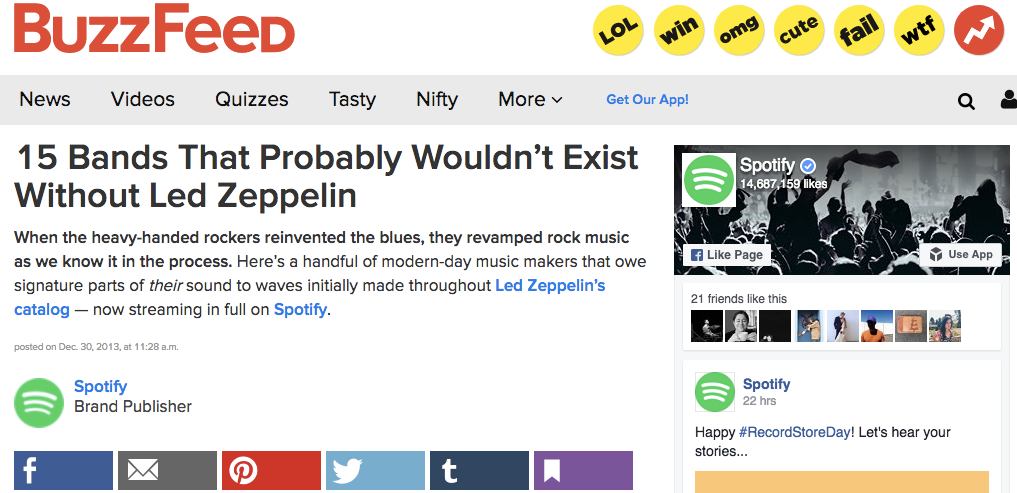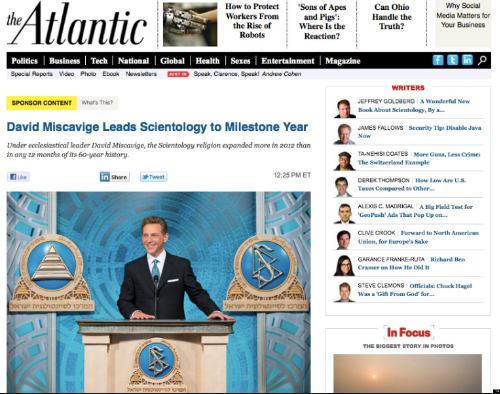Guest post presented by Maribel Creative Agency.
Native advertising has become an increasingly popular way for companies to promote themselves.
While not a novel concept — marketing firms have been producing native ads since the advent of print journalism — new questions regarding ethics and efficacy have arisen over the past couple of years. Native advertisements take many forms.

Promoted tweets on Twitter, suggested posts on Facebook, and “advertorials,” fall under the native ad umbrella. Websites like BuzzFeed and Cracked have proliferated the genre, and chances are, if you are reading this article, you have stumbled upon some form of native advertising on the web.
In case you are unfamiliar with native advertising, here’s an example:
There seems a paradoxical split in how consumers feel about native advertisements versus how they react to native advertisements. While complaints of deception and a lack of transparency reverberate throughout the market, people still engage with and consume this content marketing at a high frequency.
We have always tried to escape advertisements, no matter the medium, so marketers have had to become much more creative in the ways they deliver content.
The ads! The ads!
The efficacy of content marketing is undeniable though. This approach results in 308X more consumer attention and 18X more purchase intent than traditional banner ads. People browsing online content consistently have been trained to mentally “skip” banner ads and pop ups.
The CTR (click-through rate) of traditional advertisements is just .05% which means, 5 out of every 10,000 online impressions are engaged. Bear in mind that only a fraction of those who engage the ad go on to convert to leads and paying customers. Compare this to “promoted posts” on Facebook, which boast a 1% CTR.
Because of the effectiveness of native advertisements, they aren’t going away anytime soon. Whether through the form of Facebook Promoted Posts, informational advertorials, or sponsored content, native ads should be an important component of your marketing campaign.
The Native Advertising Institute posted this set of guidelines for native content.
- Acceptable Ads are not annoying.
- Acceptable Ads do not disrupt or distort the page content we’re trying to read.
- Acceptable Ads are transparent with us about being an ad.
- Acceptable Ads are effective without shouting at us.
- Acceptable Ads are appropriate to the site that we are on.
Following these directives, there is no inherent detriment to running a native advertising campaign. Consumers want quality content, and if it can be delivered behind your brand name, then it’s a solid avenue to take.
Here is an excellent example of native advertising done right:
Can you “spotify” the sponsor?
The name of the sponsor is clearly iterated several times, and the display of Spotify is not hidden. Their full transparency lets readers know exactly who produced the content. This allows for consumers to avoid feeling tricked into viewing the ad, while still building awareness and a positive perception of Spotify’s brand.
Four mentions of Spotify in the banner (all with clickable links to their site or social) litter the top of the page, and the author title and brand publisher clearly indicate this is sponsored content.
Seems overly-promotional, right?
But because Spotify has created engaging, entertaining, and informative content that consumers want to read, their presence in the article and transparent sponsoring of the content does them no harm.
The FTC (Federal Trade Commission) published a helpful guide for native advertising that includes:
- in clear and unambiguous language;
- as close as possible to the native ads to which they relate;
- in a font and color that’s easy to read;
- in a shade that stands out against the background;
- for video ads, on the screen long enough to be noticed, read, and understood; and
- for audio disclosures, read at a cadence that’s easy for consumers to follow and in words consumers will understand.
The only problem is, as AdWeek reported last April, 70% of native advertisements did not meet these regulations. This is where consumers show angst about native advertising, and where content marketers get it wrong.
For example, check out this widely-criticized sponsored content campaign in The Atlantic:
The producers of this post need to be more aware of the ethical concerns of running such content. Unless it is a paid subscription service, journalistic outlets rely on revenue from advertising to stay afloat.
When the Church of Scientology offers The Atlantic for sponsored content that is sure to drive traffic (read: ad revenue), it’s hard to say no. Sure, the publisher deserves derision for making this decision, but the Church of Scientology also needs to recognize that posting about their religion on a news site may not be the best method of approaching consumers.
With only a barely visible “Sponsored Content” tag before the article, this falls short of the above FTC standards. Aside from transparency being the law, making sure that people know an ad when they see it is the heart of any honest campaign.
Tips for Native Advertising Campaigns
The world of native advertising can be a complex one, but be sure you have these principles in place before worrying about the minute details.
Know Your Audience
Consumers typically don’t have a problem with native advertising when it fits seamlessly into the platform they’re using. However, when an advertisement lacks transparency or seems out of place and disingenuous, your results are likely to be undesirable.
Inserting advertisements into respected journalistic sources will not have the same effect as a list article on BuzzFeed, for example. Understanding the intent of a site and the reasoning behind why users are visiting it should be the guiding hand of your campaign.
Genuinely understanding your audience, knowing how they prefer to consume content, and knowing what publications or platforms they give their attention are critical factors to a successful native advertising / content marketing strategy.
Invest In Quality Content
The point of content marketing is to build an audience around your brand, and increase the trust between your brand and consumers by helping them rather than hard-selling them. Any business, big or small, should have time, money, and/or personnel dedicated to creating content.
But scalability can be an issue here, so small businesses are at a disadvantage. Hiring a marketing agency to draft content for you can come at a hefty price and generate slow returns, since anyone writing on your behalf will need time to overcome the learning curve of your business and industry.
While I recommend having a consistent source and voice for your content, small business budgets often just don’t allow for this luxury. However, freelance writers on sites like Upwork and WriterAccess can lessen many of the expensive fees, at least short term.
Along with supporting the development of articles, videos, and other content, be sure that a portion of your marketing budget is set aside for search engine and social media ads to drive traffic to your content. With such an astronomical amount of content available for consumption — dubbed content shock — it’s imperative that you allocate part of your budget to ads driving consumers to your content, rather than relying solely on organic growth.
Remember Consumers Are Humans, Not Clicks
Positive associations between a consumer and your business are more important than any clickthrough rate. Your ads should never interfere with the experience consumers have with your brand; they should enhance it.
A great example of this is Red Bull. I used to associate Red Bull with poor tasting energy drinks. However, since they’ve sponsored so many incredible events and stunts over the last few years, my perception of the brand has become much more complex and positive.
From sponsoring the infamous Space Jump:
To working with Planet Earth for their new series:
I now see Red Bull as a death defying, envelope-pushing brand. They understand the types of people who drink their product, and have catered to that demographic relentlessly with incredible content.
Native advertising need not be controversial to garner attention and influence perceptions of your business. If given time and care, these campaigns can become an immensely beneficial tool for any business. Strong content, targeted effectively, can drastically alter the trajectory of your brand.
With so much media stimulating today’s consumer, standing out is incredibly difficult, especially with traditional forms of messaging. While native advertisements continually rise in popularity for businesses, making sure you have a strong presence that adds value to peoples’ lives is of utmost importance.
____________
About the Author
Henry Burgess-Marshall is the Co-Founder and Head of Marketing at Maribel Creative Agency. He is an author, traveler, and believer in the power of genuine relationships. Follow him on Twitter @henryinseattle and Instagram @henryburgessmarshall




Speak Your Mind